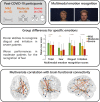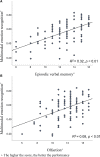Markers of limbic system damage following SARS-CoV-2 infection
- PMID: 37415776
- PMCID: PMC10320753
- DOI: 10.1093/braincomms/fcad177
Markers of limbic system damage following SARS-CoV-2 infection
Abstract
Alterations of the limbic system may be present in the chronic phase of SARS-CoV-2 infection. Our aim was to study the long-term impact of this disease on limbic system-related behaviour and its associated brain functional connectivity, according to the severity of respiratory symptoms in the acute phase. To this end, we investigated the multimodal emotion recognition abilities of 105 patients from the Geneva COVID-COG Cohort 223 days on average after SARS-CoV-2 infection (diagnosed between March 2020 and May 2021), dividing them into three groups (severe, moderate or mild) according to respiratory symptom severity in the acute phase. We used multiple regressions and partial least squares correlation analyses to investigate the relationships between emotion recognition, olfaction, cognition, neuropsychiatric symptoms and functional brain networks. Six to 9 months following SARS-CoV-2 infection, moderate patients exhibited poorer recognition abilities than mild patients for expressions of fear (P = 0.03 corrected), as did severe patients for disgust (P = 0.04 corrected) and irritation (P < 0.01 corrected). In the whole cohort, these performances were associated with decreased episodic memory and anosmia, but not with depressive symptoms, anxiety or post-traumatic stress disorder. Neuroimaging revealed a positive contribution of functional connectivity, notably between the cerebellum and the default mode, somatosensory motor and salience/ventral attention networks. These results highlight the long-term consequences of SARS-Cov-2 infection on the limbic system at both the behavioural and neuroimaging levels.
Keywords: MRI; emotion; functional connectivity; neuropsychological deficits; post-COVID syndrome.
© The Author(s) 2023. Published by Oxford University Press on behalf of the Guarantors of Brain.
Conflict of interest statement
The authors report no competing interests.
Figures





References
LinkOut - more resources
Full Text Sources
Miscellaneous
